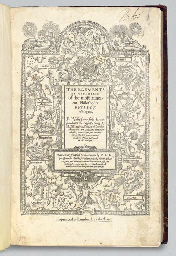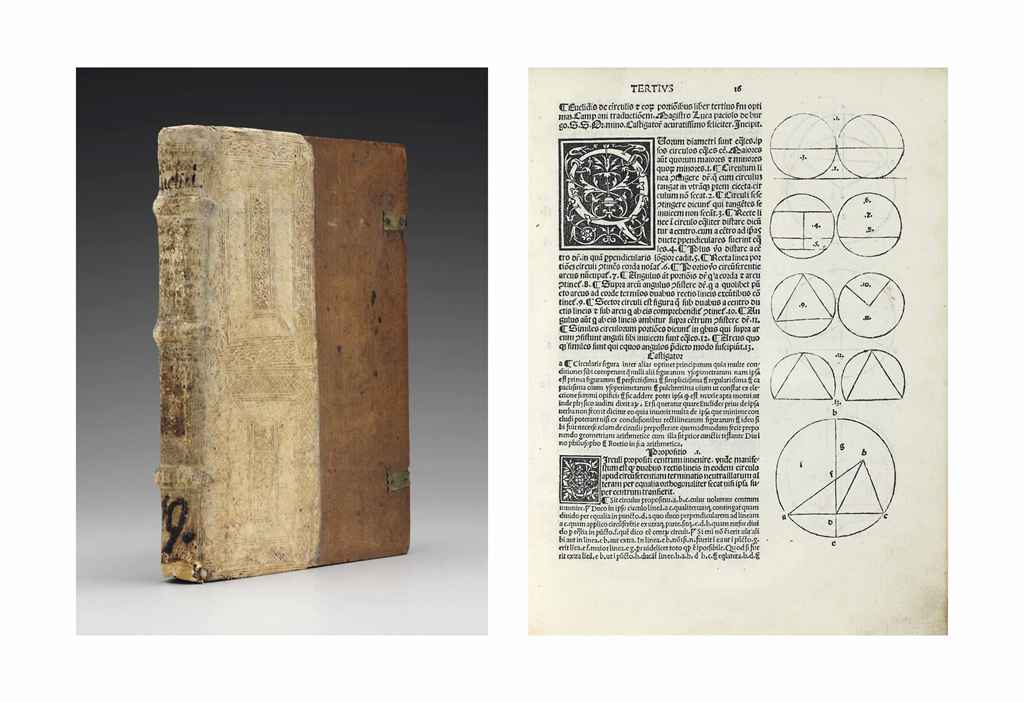EUCLID (fl. c. 300 B.C.) Elementa geometriae . Translated from the Arabic by Adelard of Bath (c. 1080-c. 1152). Edited by Giovanni Campano da Novara (1220-96). Venice: Erhard Ratdolt 25th May 1482.
EUCLID (fl. c. 300 B.C.) Elementa geometriae . Translated from the Arabic by Adelard of Bath (c. 1080-c. 1152). Edited by Giovanni Campano da Novara (1220-96). Venice: Erhard Ratdolt 25th May 1482. The first edition of the “oldest mathematical textbook still in common use today” (PMM 25) and one of the earliest printed books with geometrical figures. A large copy, with none of the diagrams cropped or shaved. Ratdolt’s edition is perhaps the most finely designed of early scientific books. His method of printing diagrams in the margins to illustrate a mathematical text and his finely printed astronomical books became the models for much subsequent scientific publishing. The text is the standard late-medieval recension of Campanus of Novara, based principally on the 12th-century translation from the Arabic by Adelard of Bath. In fact, Adelard left three Latin versions of Euclid. Campanus’s text is a free reworking of earlier Latin translations, mainly Adelard’s second version (an abbreviated paraphrase), with additional proofs. This text was reprinted more than a dozen times in the late-15th and 16th century. Thomas-Stanford 1; GW 9428; BMC V, 285; Goff E-113; Klebs 383.1; Essling 282; Dibner 100; Norman 729. Super-chancery folio (305 x 210mm). Collation as GW. 137 leaves (without final blank), complete with the publisher’s dedication to Giovanni Mocenigo, doge of Venice (a1v). Second state of the first quire, as usual. Gothic types, roman caps for headlines. Heading on a2r red-printed, three-quarter white-on-black woodcut foliate border (Redgrave border 3), possibly by Bernhard Maler, 15 ten-line and numerous five-line white-on-black woodcut initials, upwards of 500 woodcut and type-rule geometric diagrams in the margins (worming slightly affecting text at the beginning, some marginal staining.) 19th-century German brown-and-black marbled boards. Provenance : some near-contemporary marginal Latin annotations and manuscript diagrams – A. Bezodis (small name-stamp, shelf-mark in red crayon).
EUCLID (fl. c. 300 B.C.) Elementa geometriae . Translated from the Arabic by Adelard of Bath (c. 1080-c. 1152). Edited by Giovanni Campano da Novara (1220-96). Venice: Erhard Ratdolt 25th May 1482.
EUCLID (fl. c. 300 B.C.) Elementa geometriae . Translated from the Arabic by Adelard of Bath (c. 1080-c. 1152). Edited by Giovanni Campano da Novara (1220-96). Venice: Erhard Ratdolt 25th May 1482. The first edition of the “oldest mathematical textbook still in common use today” (PMM 25) and one of the earliest printed books with geometrical figures. A large copy, with none of the diagrams cropped or shaved. Ratdolt’s edition is perhaps the most finely designed of early scientific books. His method of printing diagrams in the margins to illustrate a mathematical text and his finely printed astronomical books became the models for much subsequent scientific publishing. The text is the standard late-medieval recension of Campanus of Novara, based principally on the 12th-century translation from the Arabic by Adelard of Bath. In fact, Adelard left three Latin versions of Euclid. Campanus’s text is a free reworking of earlier Latin translations, mainly Adelard’s second version (an abbreviated paraphrase), with additional proofs. This text was reprinted more than a dozen times in the late-15th and 16th century. Thomas-Stanford 1; GW 9428; BMC V, 285; Goff E-113; Klebs 383.1; Essling 282; Dibner 100; Norman 729. Super-chancery folio (305 x 210mm). Collation as GW. 137 leaves (without final blank), complete with the publisher’s dedication to Giovanni Mocenigo, doge of Venice (a1v). Second state of the first quire, as usual. Gothic types, roman caps for headlines. Heading on a2r red-printed, three-quarter white-on-black woodcut foliate border (Redgrave border 3), possibly by Bernhard Maler, 15 ten-line and numerous five-line white-on-black woodcut initials, upwards of 500 woodcut and type-rule geometric diagrams in the margins (worming slightly affecting text at the beginning, some marginal staining.) 19th-century German brown-and-black marbled boards. Provenance : some near-contemporary marginal Latin annotations and manuscript diagrams – A. Bezodis (small name-stamp, shelf-mark in red crayon).






.jpg)



.jpg)




Try LotSearch and its premium features for 7 days - without any costs!
Be notified automatically about new items in upcoming auctions.
Create an alert